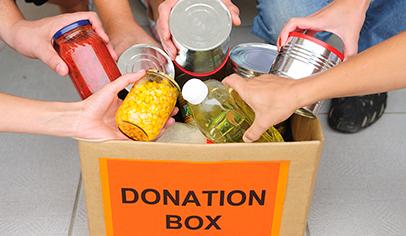Teach Children About Hunger and Poverty

Education and community service ideas that help students better understand hunger issues.
Any effort to ease hunger, such as a school food drive, will naturally raise awareness of the issue, but directly educating kids about it can truly inspire them to embrace the cause. There are so many ways to introduce children to the fact that not everybody has a full refrigerator. Here are a few suggestions.
Devote a Day to Hunger
Organize a daylong agenda where various aspects of hunger and poverty are explored. At Dudley High School in Greensboro, N.C., U.S. history students camped out in the media center from 9 a.m. to 3:45 p.m. to focus on the topic. Local nonprofits sent representatives to speak about the causes and effects of poverty at different levels of society.
Invite Speakers From Local Hunger Organizations
Ask around to learn who in your community addresses the issue of hunger. An obvious place to look is your local food pantry or food bank. But a church soup kitchen, a nonprofit agency that works with needy families, even a senior center can give students a new perspective on what it’s like to not have enough money to eat.
Do a Hunger Simulation
A powerful way to understand what it’s like to go without is to experience the feeling firsthand. Dudley High students were asked to skip both dinner and breakfast before coming to school one day. They drew slips representing developing nations, the United States, or simply being poor and were assigned meals accordingly. Another way to organize a simulation is to distribute meal tickets based on worldwide poverty levels. For example, 15 percent would be food secure and receive a nice lunch; 35 percent would be poor and get rice and beans; and 50 percent would receive only a tiny portion of rice for their meal.
Join the PTO Today community (it's free) for access to resources, giveaways and more
Don’t Skip the Nutrition
Being malnourished isn’t just about having an empty stomach. Help kids understand why a balanced diet is important and how not getting enough of certain nutrients can lead to illness (and sometimes people might even die because of it).
Help Students Process Their Experiences
When you focus on difficult issues like hunger and poverty, it’s important to provide plenty of opportunities for kids to ask questions and talk about their feelings. The Dudley High students had “debriefings” throughout the day. And after watching a presentation on childhood hunger, they each wrote a letter to someone they imagined had lost a loved one because of it.
Show Kids How They Can Help
After learning about hunger, it’s natural for children to want to do something about it. Be ready with a volunteer opportunity. Before bad weather canceled their plans, the Dudley High students were scheduled to follow their daylong hunger presentation with a trip to volunteer at the local soup kitchen.
<
Visit a Food Bank
It can be eye-opening for a child to see all that goes into feeding hungry people. If privacy isn’t an issue, arrange to go when food is being distributed. Students at the K-8 Orca School in Seattle have done that on days when their food bank is open to the elderly and the handicapped. The students got to see the produce they grew in the school garden being used to feed people who needed it to survive.
Pretend To Be a Customer
During your visit to a food bank, ask students to imagine they’re a client and have them pick out a week’s worth of food. Ask them to compare what’s in their baskets or bags with the contents of their cupboards at home. Students will come away with a deeper understanding of what life is like for people who don’t have enough money to pay for the food they need and want.






















